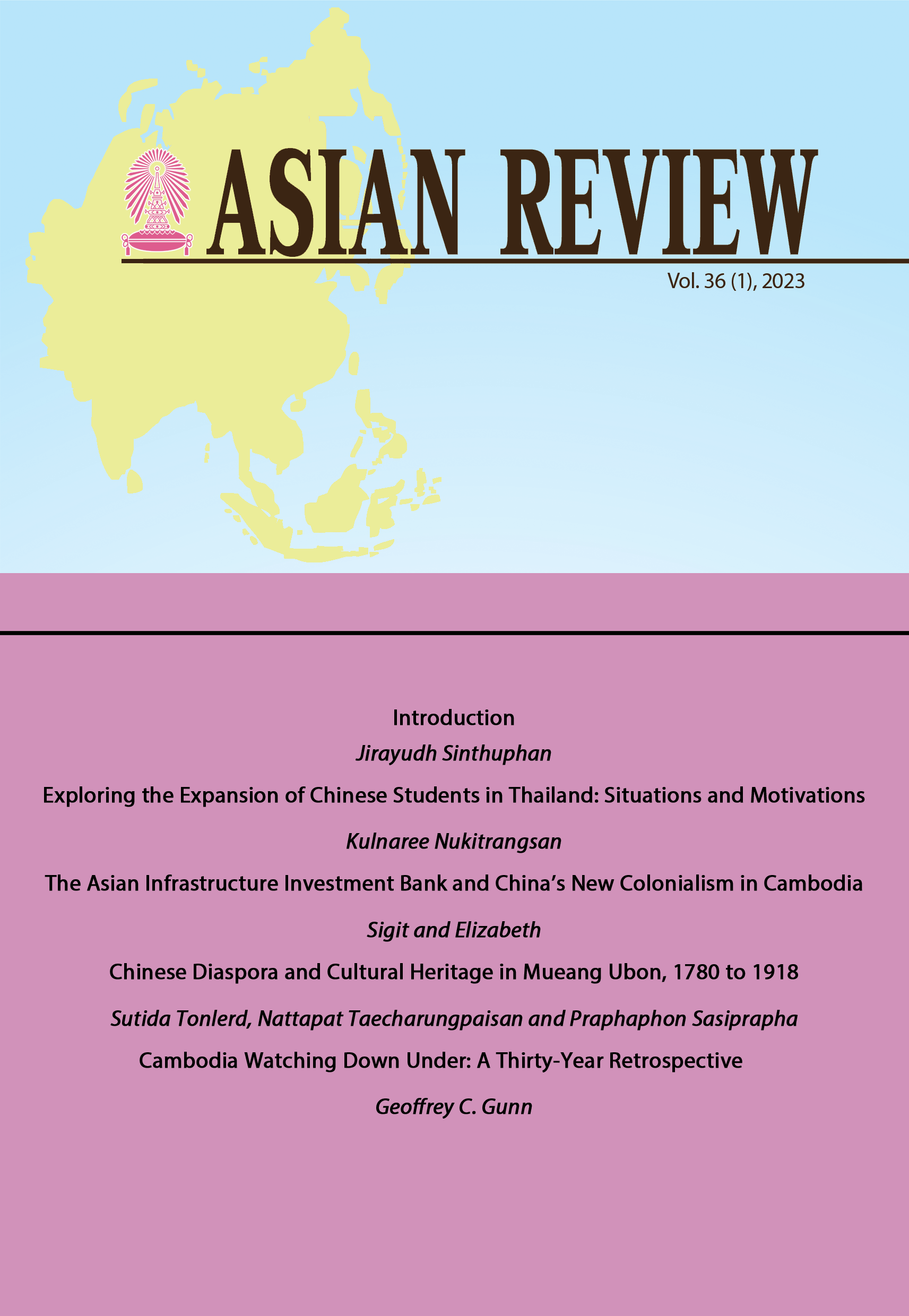The Asian Infrastructure Investment Bank and China’s New Colonialism in Cambodia
DOI:
https://doi.org/10.14456/arv.2023.2Keywords:
China, Cambodia, AIIB, BRI, New Colonialism, RenminbiAbstract
This paper aims to analyse Cambodia's response to China's new colonialism through the Asian Infrastructure Investment Bank (AIIB) using qualitative methods and hegemony as the conceptual framework. As the second-largest economy, China has ambitions to surpass other countries, such as the United States. The Belt and Road Initiative (BRI) is the first project, launched in 2013, to gain worldwide penetration of China under the mask of investment and trade. To finance BRI, China inaugurated AIIB in 2015 as its second project. AIIB invites dynamic Asian countries to invest in technology-enabled green infrastructure. After gaining the trust of Asian countries, China began to offer the internationalization of its currency, the Renminbi (RMB), as an alternative to the inability of a nation to pay its debts. This scheme succeeded in coaxing Southeast Asian countries into the Chinese colonialism trap, such as Cambodia. Phnom Penh, relying on Chinese generosity to prevent national bankruptcy, immediately agreed to the internationalization of the RMB in its country. This paper suggests that every phenomenon in the world has two opposite sides, just like two sides of a coin. Although Cambodia views RMB usage as advantageous, there are some hidden threats to its sovereignty.
References
References
AIIB. (n.d). About AIIB. https://www.aiib.org/en/about-aiib/index.html
Atthari, O. & Ejazi, E. (n.d.). The Belt and Road Initiative in the Shadow of Competition Between China and the US. https://briqjournal.com/
en/the-belt-and-road-initiative-the-shadow-competition-between-chinaand-the-us
Bell, D. (n.d). The International Political Philosophy of Pre-Qin Thinkers. http://assets.press.princeton.edu/chapters/i9427.pdf
Bong, S. 2019. Cambodia’s Disastrous Dependence on China: A History Lesson. https://thediplomat.com/2019/12/cambodias-disastrous-dependence-on-china-a-history-lesson/
Chan, S. 2018. Central Bank explains its yuan promotion policy. https://www.khmertimeskh.com/545687/central-bank-explains-its-yuan-promotionpolicy/
Dollar, D. 2015. The AIIB and the ‘One Belt, One Road’. https://www.brookings.edu/opinions/the-aiib-and-the-one-belt-one-road/amp/
Heng, P. 2018. Are China’s gifts a blessing or a curse for Cambodia? https://www.eastasiaforum.org/2018/08/29/are-chinas-gifts-a-blessing-or-a-cursefor-cambodia/
Hutt, David. 2016. How China Came to Dominate Cambodia. Retrieved from https://thediplomat.com/2016/09/how-china-came-to-dominatecambodia/
Kimsay, H. 2018. More trade in Chinese yuan. Retrieved from https://www.phnompenhpost.com/business/more-trade-chinese-yuan
Kosal, L. 2009. Sino-Cambodian Relations. https://citeseerx.ist.psu.edu/viewdoc/download?doi=10.1.1.551.4022&rep=rep1&type=pdf
Lai, E. 2021. Why Does China Want to Internationalize the RMB? https://www.scmp.com/presented/business/topics/international-trade/article/3140270/why-does-china-want-internationalize
Lim, K. 2015. Significance of AIIB for Asia and China. https://www.chinadaily.com.cn/opinion/2015-06/30/content_21142995.htm
Ly, B. 2020. The nexus of BRI and internationalization of renminbi (RMB). https://www.tandfonline.com/doi/full/10.1080/23311975.2020.1808399
Maorong, Z. 2016. Significance of Establishing the AIIB. https://www.chinausfocus.com/finance-economy/significance-of-establishing-the-aiib
Nikkei staff writers. 2021. Cambodia’s Hun Sen: ‘If I don’t rely on China, who will I rely on?’ https://asia.nikkei.com/Spotlight/The-Future-of-Asia/The-Future-of-Asia-2021/Cambodia-s-Hun-Sen-If-I-don-t-rely-on-Chinawho-
will-I-rely-on
Po, S. 2020. An “Ironclad Friend”: Explaining Cambodia’s Bandwagoning Policy towards China. https://journals.sagepub.com/doi/
full/10.1177/1868103420901879
Prasad, E. 2016. China’s Efforts to Expand the International Use of the Renminbi. Retrieved from https://www.uscc.gov/sites/default/files/Research/China%27s%20Efforts%20to%20Expand%20the%20Internationalization%20of%20the%20RMB.pdf
Rainsy, S. 2019. Cambodia Entrapped by China’s New Silk Road Dominance. Retrieved from https://thegeopolitics.com/cambodia-entrapped-by-chinas-new-silk-road-dominance/amp/
Real Instituto Elcano. (2020). RMB internationalization and the BRI: reality or fantasy? Retrieved from https://www.realinstitutoelcano.org/en/rmb-internationalization-and-the-bri-reality-or-fantasy/
Reich, S. 2015. What does the AIIB mean for US global influence? Retrieved from https://www.weforum.org/agenda/2015/04/what-does-the-aiib-mean-for-us-global-influence
Rinith, T. 2020. A long friendship: A look into the history of Sino-Cambodian relations. Retrieved from https://www.khmertimeskh.com/50768500/a-long-friendship-a-look-into-the-history-of-sino-cambodian-relations/
Schmidt, B. 2018. Hegemony: A conceptual and theoretical analysis. Retrieved from https://doc-research.org/2018/08/hegemony-conceptual-theoretical-analysis/
Sok, K. 2019. In Cambodia, the BRI must benefit locals too. Retrieved from https://www.eastasiaforum.org/2019/05/18/in-cambodia-the-bri-must-benefit-locals-too/
Suy, H. 2020. No simple solution to China’s dominance in Cambodia. Retrieved from https://www.eastasiaforum.org/2020/12/26/no-simple-solution-to-chinas-dominance-in-cambodia/
Xiong, Y. 2015. Why everyone’s joining the Asian Infrastructure Investment Bank. Retrieved from https://theconversation.com/amp/why-everyones-joining-the-asian-infrastructure-investment-bank-39256
Yan. 2017. Spotlight: Cambodia’s Central Bank Encouraging Use of Chinese Yuan. Retrieved from http://www.xinhuanet.com//english/2017-10/25/c_136703276.htm
Yang, D. 2019. China’s Choice about RMB Internationalization: Will the Belt and Road Initiative accelerate the process? Retrieved from https://projekter.aau.dk/projekter/files/305081033/Daru_Yang___China_s_Choice_about_RMB_Internationalization_Will_Belt_and_Road_Initiative_accelerate_the_process_.pdf
Downloads
Published
How to Cite
Issue
Section
License
Copyright (c) 2023 Instiute of Asian Studies, Chulalongkorn University

This work is licensed under a Creative Commons Attribution-NonCommercial-NoDerivatives 4.0 International License.
Published articles are under the copyright of the Instiute of Asian Studies, Chulalongkorn University. Partially or totally publication of an article elsewhere is possible only after the consent from the editors.







